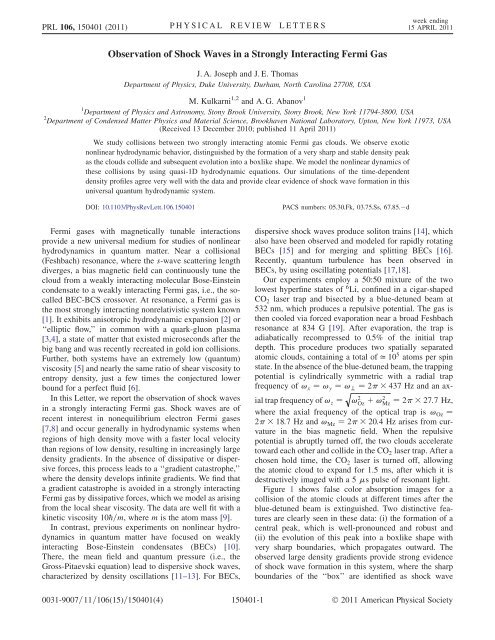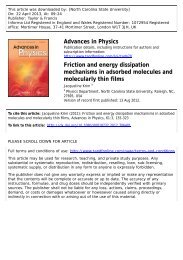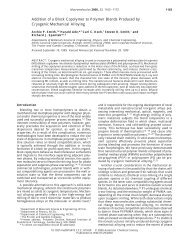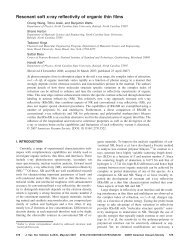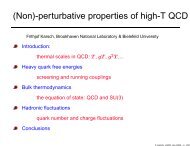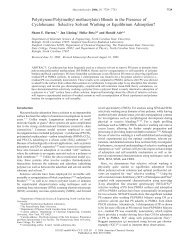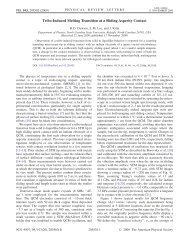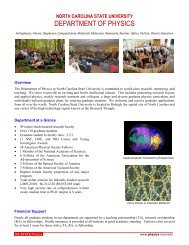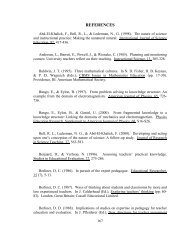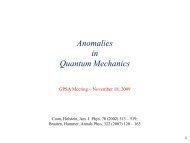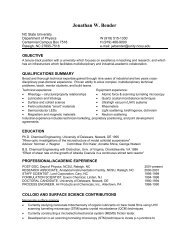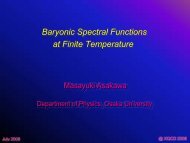Observation of Shock Waves in a Strongly Interacting ... - Physics
Observation of Shock Waves in a Strongly Interacting ... - Physics
Observation of Shock Waves in a Strongly Interacting ... - Physics
Create successful ePaper yourself
Turn your PDF publications into a flip-book with our unique Google optimized e-Paper software.
PRL 106, 150401 (2011) PHYSICAL REVIEW LETTERSweek end<strong>in</strong>g15 APRIL 2011<strong>Observation</strong> <strong>of</strong> <strong>Shock</strong> <strong>Waves</strong> <strong>in</strong> a <strong>Strongly</strong> Interact<strong>in</strong>g Fermi GasJ. A. Joseph and J. E. ThomasDepartment <strong>of</strong> <strong>Physics</strong>, Duke University, Durham, North Carol<strong>in</strong>a 27708, USAM. Kulkarni 1,2 and A. G. Abanov 11 Department <strong>of</strong> <strong>Physics</strong> and Astronomy, Stony Brook University, Stony Brook, New York 11794-3800, USA2 Department <strong>of</strong> Condensed Matter <strong>Physics</strong> and Material Science, Brookhaven National Laboratory, Upton, New York 11973, USA(Received 13 December 2010; published 11 April 2011)We study collisions between two strongly <strong>in</strong>teract<strong>in</strong>g atomic Fermi gas clouds. We observe exoticnonl<strong>in</strong>ear hydrodynamic behavior, dist<strong>in</strong>guished by the formation <strong>of</strong> a very sharp and stable density peakas the clouds collide and subsequent evolution <strong>in</strong>to a boxlike shape. We model the nonl<strong>in</strong>ear dynamics <strong>of</strong>these collisions by us<strong>in</strong>g quasi-1D hydrodynamic equations. Our simulations <strong>of</strong> the time-dependentdensity pr<strong>of</strong>iles agree very well with the data and provide clear evidence <strong>of</strong> shock wave formation <strong>in</strong> thisuniversal quantum hydrodynamic system.DOI: 10.1103/PhysRevLett.106.150401 PACS numbers: 05.30.Fk, 03.75.Ss, 67.85. dFermi gases with magnetically tunable <strong>in</strong>teractionsprovide a new universal medium for studies <strong>of</strong> nonl<strong>in</strong>earhydrodynamics <strong>in</strong> quantum matter. Near a collisional(Feshbach) resonance, where the s-wave scatter<strong>in</strong>g lengthdiverges, a bias magnetic field can cont<strong>in</strong>uously tune thecloud from a weakly <strong>in</strong>teract<strong>in</strong>g molecular Bose-E<strong>in</strong>ste<strong>in</strong>condensate to a weakly <strong>in</strong>teract<strong>in</strong>g Fermi gas, i.e., the socalledBEC-BCS crossover. At resonance, a Fermi gas isthe most strongly <strong>in</strong>teract<strong>in</strong>g nonrelativistic system known[1]. It exhibits anisotropic hydrodynamic expansion [2] or‘‘elliptic flow,’’ <strong>in</strong> common with a quark-gluon plasma[3,4], a state <strong>of</strong> matter that existed microseconds after thebig bang and was recently recreated <strong>in</strong> gold ion collisions.Further, both systems have an extremely low (quantum)viscosity [5] and nearly the same ratio <strong>of</strong> shear viscosity toentropy density, just a few times the conjectured lowerbound for a perfect fluid [6].In this Letter, we report the observation <strong>of</strong> shock waves<strong>in</strong> a strongly <strong>in</strong>teract<strong>in</strong>g Fermi gas. <strong>Shock</strong> waves are <strong>of</strong>recent <strong>in</strong>terest <strong>in</strong> nonequilibrium electron Fermi gases[7,8] and occur generally <strong>in</strong> hydrodynamic systems whenregions <strong>of</strong> high density move with a faster local velocitythan regions <strong>of</strong> low density, result<strong>in</strong>g <strong>in</strong> <strong>in</strong>creas<strong>in</strong>gly largedensity gradients. In the absence <strong>of</strong> dissipative or dispersiveforces, this process leads to a ‘‘gradient catastrophe,’’where the density develops <strong>in</strong>f<strong>in</strong>ite gradients. We f<strong>in</strong>d thata gradient catastrophe is avoided <strong>in</strong> a strongly <strong>in</strong>teract<strong>in</strong>gFermi gas by dissipative forces, which we model as aris<strong>in</strong>gfrom the local shear viscosity. The data are well fit with ak<strong>in</strong>etic viscosity 10@=m, where m is the atom mass [9].In contrast, previous experiments on nonl<strong>in</strong>ear hydrodynamics<strong>in</strong> quantum matter have focused on weakly<strong>in</strong>teract<strong>in</strong>g Bose-E<strong>in</strong>ste<strong>in</strong> condensates (BECs) [10].There, the mean field and quantum pressure (i.e., theGross-Pitaevski equation) lead to dispersive shock waves,characterized by density oscillations [11–13]. For BECs,dispersive shock waves produce soliton tra<strong>in</strong>s [14], whichalso have been observed and modeled for rapidly rotat<strong>in</strong>gBECs [15] and for merg<strong>in</strong>g and splitt<strong>in</strong>g BECs [16].Recently, quantum turbulence has been observed <strong>in</strong>BECs, by us<strong>in</strong>g oscillat<strong>in</strong>g potentials [17,18].Our experiments employ a 50:50 mixture <strong>of</strong> the twolowest hyperf<strong>in</strong>e states <strong>of</strong> 6 Li, conf<strong>in</strong>ed <strong>in</strong> a cigar-shapedCO 2 laser trap and bisected by a blue-detuned beam at532 nm, which produces a repulsive potential. The gas isthen cooled via forced evaporation near a broad Feshbachresonance at 834 G [19]. After evaporation, the trap isadiabatically recompressed to 0.5% <strong>of</strong> the <strong>in</strong>itial trapdepth. This procedure produces two spatially separatedatomic clouds, conta<strong>in</strong><strong>in</strong>g a total <strong>of</strong> ’ 10 5 atoms per sp<strong>in</strong>state. In the absence <strong>of</strong> the blue-detuned beam, the trapp<strong>in</strong>gpotential is cyl<strong>in</strong>drically symmetric with a radial trapfrequency <strong>of</strong> ! x ¼ ! y ¼ ! ? ¼ 2 437 Hz and an axialtrap frequency <strong>of</strong> ! z ¼ ! 2 Oz þ !2 Mz ¼ 2 27:7 Hz,qffiffiffiffiffiffiffiffiffiffiffiffiffiffiffiffiffiffiffiffiffiffiffiffiwhere the axial frequency <strong>of</strong> the optical trap is ! Oz ¼2 18:7 Hzand ! Mz ¼ 2 20:4 Hzarises from curvature<strong>in</strong> the bias magnetic field. When the repulsivepotential is abruptly turned <strong>of</strong>f, the two clouds acceleratetoward each other and collide <strong>in</strong> the CO 2 laser trap. After achosen hold time, the CO 2 laser is turned <strong>of</strong>f, allow<strong>in</strong>gthe atomic cloud to expand for 1.5 ms, after which it isdestructively imaged with a 5 s pulse <strong>of</strong> resonant light.Figure 1 shows false color absorption images for acollision <strong>of</strong> the atomic clouds at different times after theblue-detuned beam is ext<strong>in</strong>guished. Two dist<strong>in</strong>ctive featuresare clearly seen <strong>in</strong> these data: (i) the formation <strong>of</strong> acentral peak, which is well-pronounced and robust and(ii) the evolution <strong>of</strong> this peak <strong>in</strong>to a boxlike shape withvery sharp boundaries, which propagates outward. Theobserved large density gradients provide strong evidence<strong>of</strong> shock wave formation <strong>in</strong> this system, where the sharpboundaries <strong>of</strong> the ‘‘box’’ are identified as shock wave0031-9007=11=106(15)=150401(4) 150401-1 Ó 2011 American Physical Society
PRL 106, 150401 (2011) PHYSICAL REVIEW LETTERSweek end<strong>in</strong>g15 APRIL 2011FIG. 1 (color onl<strong>in</strong>e). Collision between two strongly <strong>in</strong>teract<strong>in</strong>g Fermi gas clouds <strong>in</strong> a cigar-shaped optical trap. The clouds are<strong>in</strong>itially separated by a repulsive 532 nm optical beam. After the 532 nm beam is ext<strong>in</strong>guished (0 ms), the clouds approach each other.False color absorption images show the spatial pr<strong>of</strong>iles versus time. Initially, a sharp rise <strong>in</strong> density occurs <strong>in</strong> the center <strong>of</strong> the collisionzone. At later times the region <strong>of</strong> high density evolves from a ‘‘peaklike’’ shape <strong>in</strong>to a ‘‘boxlike’’ shape as the shock front propagatesoutward. The well def<strong>in</strong>ed edges <strong>of</strong> the central zone <strong>in</strong> the last four images provide evidence <strong>of</strong> shock wave formation <strong>in</strong> the strongly<strong>in</strong>teract<strong>in</strong>g Fermi gas.fronts. Numerical model<strong>in</strong>g <strong>of</strong> the hydrodynamic theoryfor one-dimensional motion is used to predict the evolution<strong>of</strong> the atomic density, yield<strong>in</strong>g pr<strong>of</strong>iles <strong>in</strong> good agreementwith the data.For simplicity, we assume that the cloud is a strongly<strong>in</strong>teract<strong>in</strong>g Fermi gas at zero temperature; i.e., we modelthe cloud as a s<strong>in</strong>gle fluid, consistent with our measurements<strong>of</strong> the sound velocity [20]. In this case, the localchemical potential has the universal form ðn 3D Þ¼ð1 þÞ F ðn 3D Þ, where F ðn 3D Þ¼ @22m ð32 n 3D Þ 2=3 is the idealgas local Fermi energy correspond<strong>in</strong>g to the threedimensionaldensity n 3D . Here, ¼ 0:61 is a universalscale factor [2,21,22].Neglect<strong>in</strong>g viscous forces, the dynamics for the densityn 3D ðr;tÞ and the velocity field vðr;tÞ are described by thecont<strong>in</strong>uity equationand the Euler equation@ t n 3D þrðn 3D vÞ¼0 (1)m@ t v þr½ðn 3D ÞþU trap ðr; zÞþ 1 2 mv2 Š¼0; (2)where we assume irrotational flow. Here U trap ðrÞ ¼12 m!2 ? r2 þ 1 2 m!2 zz 2 is the conf<strong>in</strong><strong>in</strong>g harmonic potential<strong>of</strong> the cigar-shaped trap.To determ<strong>in</strong>e the <strong>in</strong>itial density pr<strong>of</strong>ile for the separatedclouds, we consider the equilibrium 3D density <strong>of</strong> theFermi gas <strong>in</strong> the trap, <strong>in</strong>clud<strong>in</strong>g a knife-shaped repulsivepotential V rep ðzÞ. A blue-detuned laser beam is shaped by acyl<strong>in</strong>drical lens telescope; i.e., the spot size is small comparedto the long dimension <strong>of</strong> the cigar-shaped cloud andlarge compared to the transverse dimension. Therefore, therepulsive potential varies only <strong>in</strong> the z (axial) direction:V rep ðzÞ ¼V 0 exp½ ðz z 0 Þ 2 = 2 zŠ. We measure the width z ¼ 21:2 m. The <strong>of</strong>fset z 0 ¼ 5 m <strong>of</strong> the focus fromthe center <strong>in</strong> the long direction <strong>of</strong> the optical trap isdeterm<strong>in</strong>ed by a fit to the first density pr<strong>of</strong>ile at 0 ms.Us<strong>in</strong>g the beam <strong>in</strong>tensity and the ground state static polarizability<strong>of</strong> 6 Li at 532 nm, we f<strong>in</strong>d V 0 ¼ 12:7 K. The<strong>in</strong>itial density pr<strong>of</strong>ile is thenn 3D ðr; zÞ ¼~n 1r 2R 2 ?z 2R 2 zV rep ðzÞ G 3=2;(3)where ~n ¼½ð2m G =@ 2 Þ=ð1 þ ÞŠ 3=2 =ð3 2 Þ. In Eq. (3),qffiffiffiffiffiffiffiffiffiffiffiffiffiffiffiffiffiffiffiffiffiffiffiffiffiffiffiffiffiR z;? ¼ 2 G =ðm! 2 z;? Þ and G is the global chemicalpotential, which is determ<strong>in</strong>ed by normaliz<strong>in</strong>g the <strong>in</strong>tegral<strong>of</strong> the 3D density to the total number N <strong>of</strong> atoms <strong>in</strong> bothsp<strong>in</strong> states. For N ¼ 2 10 5 , we f<strong>in</strong>d G ¼ 0:53 K,R z ¼ 220 m, and R ? ¼ 14 m.We note that G =ð@! ? Þ¼27, which means that thetypical number <strong>of</strong> filled energy levels <strong>of</strong> transverse quantizationis large. Therefore, <strong>in</strong> this Letter, we use 3Dhydrodynamics [Eqs. (1) and (2)] and neglect effects <strong>of</strong>transverse quantization even though they are more pronounced<strong>in</strong> regions with lower density.We model the dynamics for the one-dimensional motion<strong>in</strong> the long direction <strong>of</strong> the cigar-shaped trap. Just after theblue-detuned beam is ext<strong>in</strong>guished, the <strong>in</strong>itial 1D densitypr<strong>of</strong>ile is determ<strong>in</strong>ed by <strong>in</strong>tegrat<strong>in</strong>g n 3D <strong>of</strong> Eq. (3) over thetransverse dimension r:n 1D ðzÞ ¼ 2 5 R2 ? ~n 1z 2R 2 zV rep ðzÞ G 5=2:(4)In the follow<strong>in</strong>g, we assume that dur<strong>in</strong>g the evolution ther dependence <strong>of</strong> Eq. (3) is preserved with the effective size<strong>of</strong> the cloud be<strong>in</strong>g a slow function <strong>of</strong> z and t. We alsoassume that the hydrodynamic velocity is along the z axis150401-2
PRL 106, 150401 (2011) PHYSICAL REVIEW LETTERSweek end<strong>in</strong>g15 APRIL 2011and does not depend on r. Then the subsequent timeevolution <strong>of</strong> the density follows the quasi-1D nonl<strong>in</strong>earhydrodynamic equations:@ t n ¼ @ z ðnvÞ; (5)@ t v ¼ @ z v22 þ Cn2=5 þ 1 2 !2 zz 2 þ @ zðn@ z vÞ; (6)nwhere C ¼ 1 2 !2 ? l2 ? ð15 2 l ?Þ 2=5 ð1 þ Þ 3=5 and l ? ¼pffiffiffiffiffiffiffiffiffiffiffiffiffiffiffiffiffiffiffiffi@=ðm! ? Þ is the oscillator length. For brevity, we haveomitted the subscript 1D <strong>in</strong> Eqs. (5) and (6). The last‘‘viscosity’’ term <strong>in</strong> Eq. (6) is added phenomenologicallyto describe dissipative effects. For the strongly <strong>in</strong>teract<strong>in</strong>g1D fluid, is the effective k<strong>in</strong>ematic viscosity, which hasa natural scale @=m. It is the only fitt<strong>in</strong>g parameter <strong>in</strong> thetheory [9].For our previous sound wave experiments [20], weobserved nonl<strong>in</strong>ear (amplitude-dependent) propagationwithout shock waves. By reduc<strong>in</strong>g the density perturbation,we observed l<strong>in</strong>ear propagation. In this regime, one canexpand the differential equations (5) and (6) around anequilibrium density configuration n 0 ðzÞ <strong>in</strong> a harmonictrap. By def<strong>in</strong><strong>in</strong>g nðz; tÞ n 0 ðzÞþnðz; tÞ, the l<strong>in</strong>earizedevolution equation for nðz; tÞ (neglect<strong>in</strong>g viscosity) is 2C@ 2 t n ¼ @ z n 0 @ z5m n ð3=5Þ0n : (7)With a flat background density, i.e., constant n 0 , with G ¼ Cn 2=50 , Eq. (7) reduces to @ 2 t n ¼ c 2 @ 2 zn with thepsound velocity c ¼ffiffiffiffiffiffiffiffiffiffiffiffiffiffiffiffiffiffi2 G =5m, <strong>in</strong> agreement with predictions[23,24].To compare the numerical solutions <strong>of</strong> Eqs. (5) and (6)with experiment, we note that the images are taken after anadditional free expansion for 1.5 ms, dur<strong>in</strong>g which n 1Dcont<strong>in</strong>ues to slowly evolve <strong>in</strong> the axial potential <strong>of</strong> the biasmagnetic field, i.e., ! z ! ! Mz ¼ 2 20:4 Hz. We assumethat, dur<strong>in</strong>g this expansion, the transverse densitypr<strong>of</strong>iles keep the same form, but the radius <strong>in</strong>creases withtime. Then n 3D ðr; zÞ !n 3D ðr=b ? ;zÞ=b 2 ? , where b ?ðtÞ is atransverse scale factor, which obeys €b ? ¼ ! 2 ? b 7=3? , withb ? ð0Þ ¼1 and b _ ? ð0Þ ¼0 [2,25,26]. S<strong>in</strong>ce the 3D pressurescales as n 5=34=33D, the 1D pressure scales as b? . This leads toa simple modification <strong>of</strong> Eq. (6): C ! CðtÞ ¼C=b 4=3? ðtÞ.We numerically <strong>in</strong>tegrate Eqs. (5) and (6) by us<strong>in</strong>g themeasured values <strong>of</strong> the trap frequencies, the atom number,and the <strong>of</strong>fset, depth, and width <strong>of</strong> the repulsive potential.In the numerical simulation, we create and load a densityarray as well as a velocity array with grid spac<strong>in</strong>g z . The<strong>in</strong>itial velocity is set to zero. The simulation then updatesthe density and velocity field <strong>in</strong> discrete time steps taccord<strong>in</strong>g to Eqs. (5) and (6). The 1D density pr<strong>of</strong>iles arecalculated as a function <strong>of</strong> time after the repulsive potentialis ext<strong>in</strong>guished. Figure 2 shows the predictions and theFIG. 2 (color onl<strong>in</strong>e). 1D density pr<strong>of</strong>iles divided by the totalnumber <strong>of</strong> atoms versus time for two collid<strong>in</strong>g strongly <strong>in</strong>teract<strong>in</strong>gFermi gas clouds. The normalized density is <strong>in</strong> units <strong>of</strong>10 2 =m per particle. Red dots show the measured 1D densitypr<strong>of</strong>iles. Black curves show the simulation, which uses themeasured trap parameters and the number <strong>of</strong> atoms, with thek<strong>in</strong>etic viscosity as the only fitt<strong>in</strong>g parameter.data, which are <strong>in</strong> very good agreement. For the simulationcurves shown <strong>in</strong> the figure, we use a grid <strong>of</strong> 150 po<strong>in</strong>ts.To check for numerical consistency, we also employ asmoothed-particle-hydrodynamics [27] approach, wherethe fluid is described by discrete pseudoparticles. Theresults obta<strong>in</strong>ed <strong>in</strong>deed co<strong>in</strong>cide with the discretized-gridapproach described above.As shown <strong>in</strong> Fig. 2, we observe a dramatic evolution forthe density <strong>of</strong> the gas. Dur<strong>in</strong>g the collision, a dist<strong>in</strong>ct andstable density peak forms at the po<strong>in</strong>t <strong>of</strong> collision <strong>in</strong> thecenter <strong>of</strong> the trap [28]. The density gradient at the side <strong>of</strong>the central peak <strong>in</strong>creases from its onset until 3ms,at which po<strong>in</strong>t the gradient reaches its maximum value.A large gradient at the edge <strong>of</strong> the collision zone is ma<strong>in</strong>ta<strong>in</strong>edthroughout the rest <strong>of</strong> the experiment. For most<strong>of</strong> the data, we f<strong>in</strong>d relatively small deviations from thesimulation. The largest deviation occurs at 4 ms, where themaximum density <strong>of</strong> the observed central peak exceedsthat <strong>of</strong> the simulation by ’ 20%.The steep density gradients observed <strong>in</strong> Fig. 1 suggestshock wave formation. A deeper analysis <strong>of</strong> the simulation150401-3
PRL 106, 150401 (2011) PHYSICAL REVIEW LETTERSweek end<strong>in</strong>g15 APRIL 2011curves provides additional evidence for shock waves.Without any dissipation, the numerical <strong>in</strong>tegration <strong>of</strong> thequasi-1D theory breaks down due to a gradient catastrophe.We f<strong>in</strong>d that the dissipative force <strong>in</strong> Eq. (6), which isdescribed by the k<strong>in</strong>ematic viscosity coefficient , isrequired to attenuate the large density gradients and avoidgradient catastrophe. For the data shown <strong>in</strong> Fig. 2, we f<strong>in</strong>dthat the best fits are obta<strong>in</strong>ed with the viscosity parameter ¼ 10@=m. For smaller values <strong>of</strong> , the simulation producesqualitatively similar results to those shown <strong>in</strong> thefigure, only with steeper density gradients at the edges <strong>of</strong>the collision zone. The dissipative term / has a relativelysmall effect on the density pr<strong>of</strong>iles, unless we are <strong>in</strong> a shockwave regime, where the density gradients are large. Hence,the numerical model suggests that the large density gradientobserved at the edge <strong>of</strong> the collision zone is thelead<strong>in</strong>g edge <strong>of</strong> a dissipative shock wave.Our one-dimensional data for a strongly <strong>in</strong>teract<strong>in</strong>gFermi gas are very well described by a model based ondissipative nonl<strong>in</strong>ear quantum hydrodynamics. The modelemploys an effective chemical potential 1D ¼ Cn 2=51D ,assum<strong>in</strong>g a s<strong>in</strong>gle fluid near the ground state. However,we expect that at higher temperatures, even <strong>in</strong> the normalfluid regime, rapid collisional equilibrium <strong>in</strong> the strongly<strong>in</strong>teract<strong>in</strong>g gas will produce nearly adiabatic evolutionwith a three-dimensional pressure / n 5=3 and, hence, anidentical power-law dependence for the effective onedimensionalchemical potential. The radial density variationsobserved <strong>in</strong> the two-dimensional image are notcaptured <strong>in</strong> the one-dimensional pr<strong>of</strong>iles but may bestudied by expand<strong>in</strong>g the numerical analysis to threedimensions.In conclusion, we have observed shock waves <strong>in</strong> astrongly <strong>in</strong>teract<strong>in</strong>g Fermi gas, which provides an entirelynew regime for studies <strong>of</strong> nonl<strong>in</strong>ear wave propagation <strong>in</strong>cold quantum gases. Studies <strong>of</strong> nonl<strong>in</strong>ear hydrodynamicscan now be done over a wide range <strong>of</strong> temperatures, <strong>in</strong> boththe superfluid and normal fluid regimes, and magnetic fieldcontrol <strong>of</strong> the <strong>in</strong>teraction strength enables cont<strong>in</strong>uous tun<strong>in</strong>gfrom a dispersive BEC to a dissipative Fermi gas. Infuture work, it will be <strong>in</strong>terest<strong>in</strong>g to study the orig<strong>in</strong> <strong>of</strong> theeffective viscosity, the effects <strong>of</strong> transverse quantization,and the higher derivative dispersive terms <strong>in</strong> the stresstensor [7,8,11,29], which become important for large densitygradients.The work <strong>of</strong> the Duke group is supported by the <strong>Physics</strong>Divisions <strong>of</strong> the National Science Foundation, the ArmyResearch Office, the Air Force Office <strong>of</strong> SponsoredResearch, and the Division <strong>of</strong> Materials Science andEng<strong>in</strong>eer<strong>in</strong>g, the Office <strong>of</strong> Basic Energy Sciences, Office<strong>of</strong> Science, U.S. Department <strong>of</strong> Energy. The work <strong>of</strong>A. G. A. was supported by the NSF under GrantNo. DMR-0906866. We are grateful to P. Wiegmann, E.Shuryak, D. Schneble, and F. Franch<strong>in</strong>i for usefuldiscussions.[1] G. Rupak and T. Schäfer, Phys. Rev. A 76, 053607 (2007).[2] K. M. O’Hara, S. L. Hemmer, M. E. Gehm, S. R. Granade,and J. E. Thomas, Science 298, 2179 (2002).[3] J. E. Thomas, Phys. Today 63, No. 5, 34 (2010).[4] P. F. Kolb and U. He<strong>in</strong>z, Quark Gluon Plasma (WorldScientific, S<strong>in</strong>gapore, 2003), Vol. 3, p. 634.[5] C. Cao, E. Elliott, J. Joseph, H. Wu, J. Petricka, T. Schäfer,and J. E. Thomas, Science 331, 58 (2010).[6] P. K. Kovtun, D. T. Son, and A. O. Star<strong>in</strong>ets, Phys. Rev.Lett. 94, 111601 (2005).[7] E. Bettelheim, A. G. Abanov, and P. Wiegmann, Phys.Rev. Lett. 97, 246401 (2006).[8] E. Bettelheim, A. G. Abanov, and P. Wiegmann, Phys.Rev. Lett. 97, 246402 (2006).[9] In a unitary Fermi gas, which is scale <strong>in</strong>variant, the bulkviscosity vanishes. We expect that the k<strong>in</strong>etic viscosity arises from the shear viscosity [5], which has a naturalscale / @n, so that ¼ =ðnmÞ /@=m.[10] R. Carretero-González, D. J. Frantzeskakis, and P. G.Kevrekidis, Nonl<strong>in</strong>earity 21, R139 (2008).[11] M. A. Hoefer, M. J. Ablowitz, I. Codd<strong>in</strong>gton, E. A.Cornell, P. Engels, and V. Schweikhard, Phys. Rev. A74, 023623 (2006).[12] B. Damski, Phys. Rev. A 69, 043610 (2004).[13] A. M. Kamchatnov, A. Gammal, and R. A. Kraenkel, Phys.Rev. A 69, 063605 (2004).[14] Z. Dutton, M. Budde, C. Slowe, and L. V. Hau, Science293, 663 (2001).[15] T. P. Simula, P. Engels, I. Codd<strong>in</strong>gton, V. Schweikhard,E. A. Cornell, and R. J. Ballagh, Phys. Rev. Lett. 94,080404 (2005).[16] J. J. Chang, P. Engels, and M. A. Hoefer, Phys. Rev. Lett.101, 170404 (2008).[17] E. A. L. Henn, J. A. Seman, G. Roati, K. M. F. Magalhães,and V. S. Bagnato, Phys. Rev. Lett. 103, 045301 (2009).[18] K. Fujimoto and M. Tsubota, Phys. Rev. A 82, 043611(2010).[19] M. Bartenste<strong>in</strong> et al., Phys. Rev. Lett. 94, 103201(2005).[20] J. Joseph, B. Clancy, L. Luo, J. K<strong>in</strong>ast, A. Turlapov, andJ. E. Thomas, Phys. Rev. Lett. 98, 170401 (2007).[21] H. Heiselberg, Phys. Rev. A 63, 043606 (2001).[22] L. Luo and J. E. Thomas, J. Low Temp. Phys. 154, 1(2008).[23] P. Capuzzi, P. Vignolo, F. Federici, and M. P. Tosi, Phys.Rev. A 73, 021603(R) (2006).[24] G. Berta<strong>in</strong>a, L. Pitaevskii, and S. Str<strong>in</strong>gari, Phys. Rev.Lett. 105, 150402 (2010).[25] C. Menotti, P. Pedri, and S. Str<strong>in</strong>gari, Phys. Rev. Lett. 89,250402 (2002).[26] S. Giorg<strong>in</strong>i, L. Pitaevskii, and S. Str<strong>in</strong>gari, Rev. Mod.Phys. 80, 1215 (2008).[27] J. Monaghan, Comput. Phys. Commun. 48, 89 (1988).[28] In l<strong>in</strong>ear hydrodynamics one also observes a peak formation,which can be <strong>in</strong>terpreted as a residual background <strong>in</strong>the middle after a small <strong>in</strong>itial dip splits <strong>in</strong>to left and rightmov<strong>in</strong>g dips (as observed <strong>in</strong> Ref. [20]).[29] R. Meppel<strong>in</strong>k, S. B. Koller, J. M. Vogels, P. van derStraten, E. D. van Ooijen, N. R. Heckenberg, H.Rub<strong>in</strong>szte<strong>in</strong>-Dunlop, S. A. Ha<strong>in</strong>e, and M. J. Davis, Phys.Rev. A 80, 043606 (2009).150401-4


